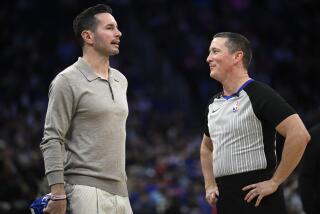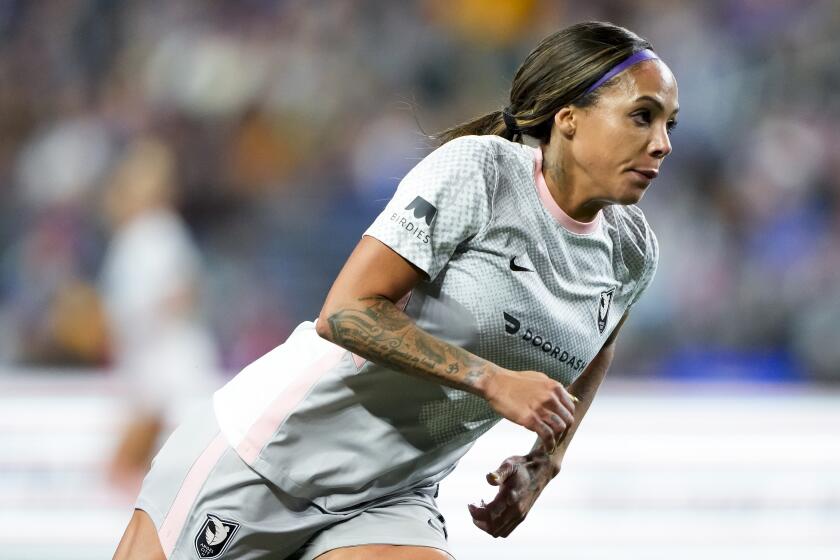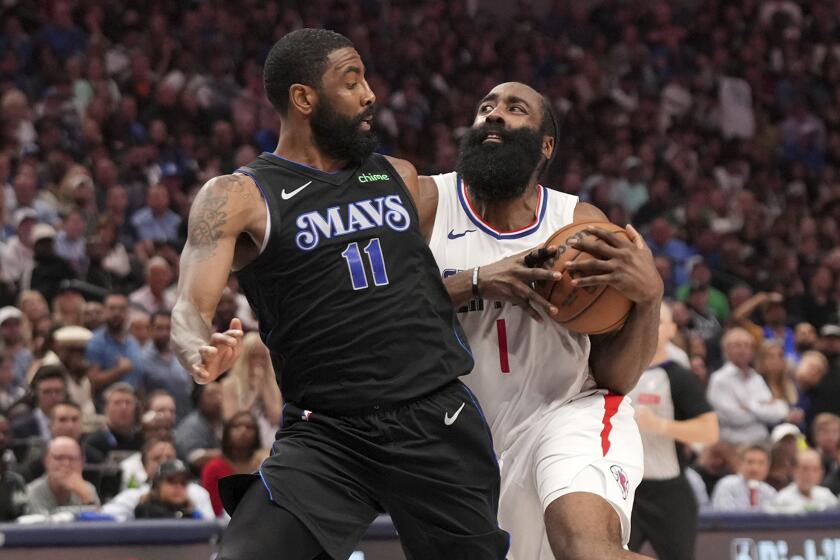THOROUGHBRED RACING : When Seeking Horse to Win Derby, This Pattern Pretty Tough to Break
The early deadline for nominating horses to this year’s Triple Crown races is Jan. 18. After that, for an extra $3,900--a total of $4,500--horses can still be nominated by April 1.
For hundreds of just-turned 3-year-olds, however, it is already too late: Time, in effect, ran out Tuesday for winning the May 2 Kentucky Derby, first race in the Triple Crown series. These can’t-win Kentucky Derby horses are the colts and fillies who didn’t race in 1991, when they were 2-year-olds.
It’s all but impossible for a 2-year-old that did not race to win the Derby.
And if it weren’t for Apollo--the original Apollo, not the one who has been campaigning in California and elsewhere the last couple of years--it could be said that a Derby winner has always had at least one race the year before.
But in 1882, at the eighth Derby, Apollo won without seasoning as a juvenile. His handlers could be accused of overreacting after that. By the time the year was over, Apollo had run 21 times, and the next year he raced 30 times. Apollo won 24 races, so he was much more than a one-race wonder, but when his career lurched to a finish at Jerome Park in New York on Sept. 30, 1884, he was running for a $500 claiming price against horses priced at $2,000.
There are dozens of ways to eliminate horses from consideration in the Kentucky Derby. Dosage, the system of tracing the stamina and speed in a horse’s pedigree, hasn’t done a bad job, despite its work-backward methodology and many detractors. Geldings seldom win a Derby. In fact, seven have finished first at Churchill Downs, but none since Clyde Van Dusen in 1929.
Maidens rarely win the Derby. Winners of the California Derby don’t win the Kentucky Derby, and until Sunny’s Halo, in 1983, a winner of the Arkansas Derby had never won the Kentucky Derby.
But the Apollo Rule for the Derby is still the best. Once out of 117 years is more than a coincidence, it’s a pattern that should have already been hammered into stone. Trainers Charlie Whittingham, Wayne Lukas and Shug McGaughey may have late-developing horses hiding in their barns, but if they didn’t get to the races by Dec. 31, going to the Derby is foolhardy.
Air Forbes Won, a son of 1976 Derby winner Bold Forbes, went into the 1982 Derby undefeated in his only four races, including a victory in the Wood Memorial, a traditional Derby prep. In the 30 previous years, there had been only six undefeated horses to run in the Derby. Two of them--Seattle Slew and Majestic Prince--won.
More than 140,000 people bet at the track in 1982, and the consensus couldn’t be faulted for sending Air Forbes Won off as the 5-2 favorite. But they overlooked the Apollo Rule. Air Forbes Won didn’t run his first race until March 4, 1982. That was more than three months late. He finished seventh in the Derby, and while the Daily Racing Form’s chart indicated that Air Forbes Won tired after looming in third place throughout the race, it wasn’t the 1,234-foot stretch at Churchill that stopped the colt. He fatigued because of the Apollo Rule.
In the 1973 Derby, a future horse of the year besides Secretariat was running. Big and awkward, he hadn’t gotten to the races until January of that year at Hialeah. As the favorite, in his first race around two turns, he had finished a strong second in the Florida Derby. But it was folly to run Forego in the Kentucky Derby. Not only was he bucking the Apollo Rule, he was also a gelding. Forego finished fourth in Louisville. In his next 29 starts, over three years, he finished as far back as fourth only once.
In the last 30 years, trainers have repeatedly flouted the Apollo Rule, and have been sorry each time.
One of the best unraced 2-year-olds to run in the Derby was Agitate, who ran third behind Cannonade and Hudson County in the 100th anniversary of the race in 1974. Besides the Apollo Rule, Agitate had an extra handicap. He was also the winner of the California Derby.
Horses packing the Apollo Rule beside their 126 pounds in the Kentucky Derby would be fortunate to do as well as Agitate. In 1984, Majestic Shore did not race until March, a maiden until April. His jockey, John Lively, eased him up before they completed the backstretch of the Derby.
In 1977, Best Person was another Apollo Rule Derby horse who finished last. Fourulla, who didn’t start at the races until March 1971, beat only one of 19 rivals in the Derby that year.
There were only 10 horses in the 1979 Derby--there hasn’t been a smaller field since--and Great Redeemer couldn’t beat any of them. Great Redeemer was also a maiden, and had averaged a race a week in the six weeks before the Derby. In fact, the Derby was his third start in seven days. His Derby odds of 78-1 seemed a little low. His finish, 47 lengths and about 30 seconds behind the winner, Spectacular Bid, was just about right. Great Redeemer may have fit the Apollo Rule, but that wasn’t a factor.
Some people, their memories tricking them, remember Lucky Debonair as winning the 1965 Derby after having no races in 1964. But Lucky Debonair did get to the races once as a 2-year-old, running sixth at Atlantic City in September of ’64.
On Jan. 5, 1965, in his next start, Lucky Debonair was second against maidens at Santa Anita after a horrible trip. He was 43-1 and probably best.
Seven days later, Frank Catrone, his trainer, ran him back, and Lucky Debonair won in a gallop at 5-2. “I’m glad he won,” Catrone told a friend later. “But I sure wish he would have won the other day. I had $200 across the board on him then.”
Lucky Debonair kept winning--the San Vicente Handicap, the Santa Anita Derby, the Blue Grass Stakes at Keeneland and then the Kentucky Derby. There was no Apollo Rule to get in the colt’s way. That sixth-place finish in New Jersey the previous fall might have seemed inconsequential. But as history continues to show, it was doubtless the difference between winning and losing the Derby.
Horse Racing Notes
The only winning ticket on Wednesday’s Pick Six, which was worth $514,260.40, was cashed Thursday at Santa Anita. The two holders of the $8 ticket declined to be identified. They bet single horses in races four through seven and had two horses each for races eight and nine. They also cashed two consolation bets, worth more than $6,000 apiece, and their net after taxes was $421,094. The gross payoff is the third highest at Santa Anita. The record payoff is $976,229.60, set in 1986.
Seven horses are entered in Saturday’s $75,000 La Centinela Stakes, for 3-year-old fillies at a mile, but the possibility of rain could affect the status of some. Fantastic Kim, who beat Queens Court Queen by a head last month at Hollywood Park, is scheduled to face that rival again, along with Crownette, Green Vitamins, Miss Turkana, Centurn and Icy Eyes. Chris McCarron, who has the assignment on Fantastic Kim, has won the stake seven times.
Santa Anita will take betting on an extra race Saturday, the California Juvenile from Bay Meadows. . . . Rayetta Burr of Benoit and Associates of Manhattan Beach has won an Eclipse Award for photography for the second time. Her photograph of rapper Hammer and his family cheering on their Lite Light at Belmont Park was judged the best racing shot of 1991. Burr also won in 1983 with a picture of John Henry at Santa Anita. She is only the second double winner in the photo category, which began in 1971.
More to Read
Get our high school sports newsletter
Prep Rally is devoted to the SoCal high school sports experience, bringing you scores, stories and a behind-the-scenes look at what makes prep sports so popular.
You may occasionally receive promotional content from the Los Angeles Times.






